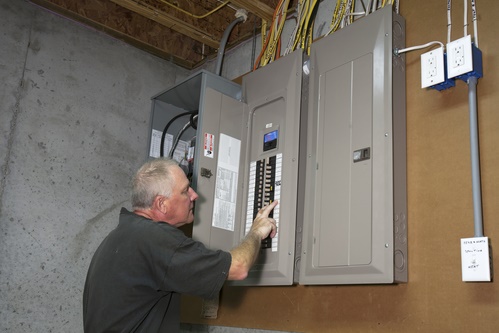Today’s electrical systems are built with circuit breakers rather than fuse boxes. A fuse box installed in the last 60 or so years should be grounded, but even older ones may indeed have always been ungrounded.
If your fuse box is ungrounded or the grounding wires appear to be damaged, you absolutely need it fixed! The best solution may be to upgrade the fuse box to a circuit breaker panel. Short of that, make sure to get your electrical system properly grounded for safety reasons.
Without proper grounding, electricity will use your body as a conduit to the earth. Yep, that means electrocution. Most everyone should call on a local electrician to ground a fuse box due to the physical risks and potential property damage of a mis-wired system.

If you have electrical experience and want to add grounding yourself, or you want to know what the process entails, here’s how it works:
Grounding a Fuse Box
The grounding system consists of copper wire that runs from the fuse box to a metal rod buried in the earth outside. Here are the parts and how they connect:
Ground Rod: This copper rod must be buried in the ground near the electrical service entry point (for a single-family home, this should be near the meter). Several inches of the rod remain exposed above ground.
Ground Rod Connector: This metal bracket clamps onto the ground rod.
Ground Wire: A bare copper wire runs from the connector to the fuse box. At the connector and in any outdoor or through-wall areas, the bare wire needs to be covered for protection.
Inside the Fuse Box: A neutral bar (a metal strip with terminals for various connections) receives the bare ground wire, connecting the power supply to the ground rod. Another wire should connect the neutral bar to the neutral wire of the main power supply.
Grounding Outlets
Old fuse box electrical systems were installed with ungrounded outlets. If you still have two-prong outlets, these boxes are not grounded. The third prong on modern outlets is for grounding. The grounded fuse box offers protection, but it’s best to have all your outlets grounded to prevent appliance damage, fires, or electrocution.
Many people can handle the task of replacing an electrical outlet as a DIY project. You will need tools to cut and crimp wires, and it’s important to know electrical safety basics before starting. Essentially, you are removing the two-prong receptacle and replacing it with a new one. If you are unsure of how to wire the ground wire to the receptacle or no ground wire is present, definitely call a professional electrician for help.
Another option is to upgrade to GFCI receptacles. This is only necessary in potentially wet locations like the bathroom, kitchen, and outdoors — but there’s no harm in adding ground fault protection anywhere.
Repairing or Upgrading an Old Fuse Box
Let the pros make sure your electrical system is supplying power safely. We can repair and restore antique and vintage equipment, or we can upgrade your fuse box to a modern breaker panel.
For help grounding a fuse box or making electrical system repairs and upgrades, contact us for professional and friendly service in Marin and Sonoma Counties.

